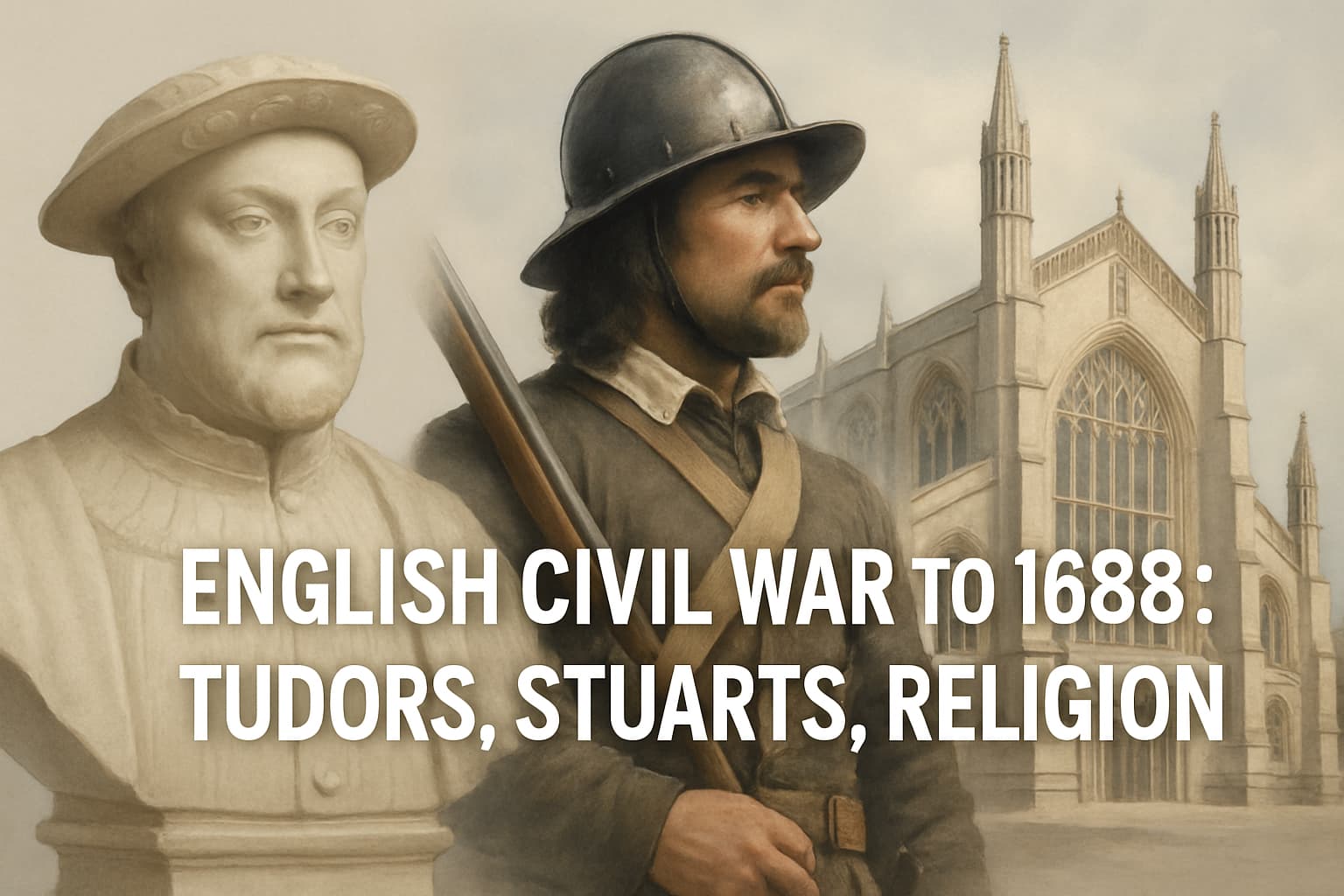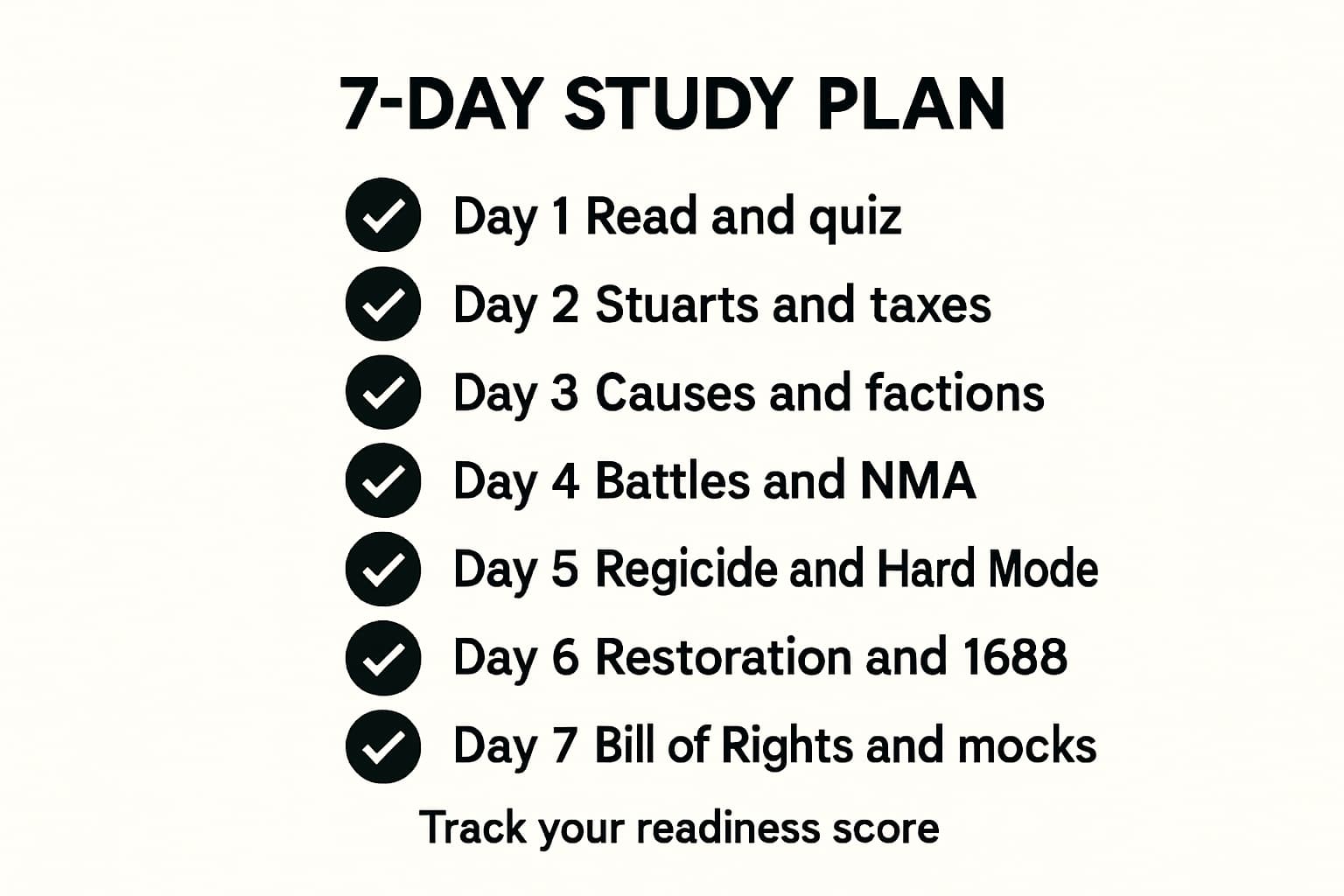English Civil War to 1688: Tudors, Stuarts, Religion

Struggling to connect the Tudors, the English Civil War, and the Glorious Revolution? This is one of the most-tested storylines in the Life in the UK Test.
Use this focused, exam-first guide to master dates, causes, and outcomes in under an hour, then lock it in with a 7-day microplan and realistic practice.
Concise Tudor-to-Stuart timeline
Cause-and-effect chains and turning points
Exam-style quick checks + a step-by-step study plan
New to the exam? See what the Life in the UK Test involves.
Why the English Civil War matters for your Life in the UK Test
The monarchy–religion story from the Tudors to the Stuarts ties directly to the English Civil War and ends with the Glorious Revolution. Examiners use it to test whether you understand how power shifted from crown to Parliament and how religious change shaped politics.
Definition: The English Civil War (1642–1651) was a series of conflicts between supporters of King Charles I (Royalists) and supporters of Parliament (Parliamentarians) that led to the king’s trial and execution, a republic under Cromwell, and eventually a constitutional monarchy.
What examiners want you to know
Dates: 1530s Reformation; 1642 war begins; 1649 execution; 1660 Restoration; 1688–89 Glorious Revolution; 1689 Bill of Rights.
Causes: money and taxation disputes, royal prerogative, religious tensions, short-term triggers (Irish Rebellion, Grand Remonstrance).
Outcomes: limits on monarchy, rise of Parliament, shifts in religious toleration.
Continuity: Tudor religious change set the stage for Stuart constitutional conflict.
How this guide will help you pass
Focused timeline that highlights only exam-relevant milestones.
Cause-and-effect chains that connect Tudors to 1688 in 8 steps.
Quick checks to test recall in under 30 seconds.
Actionable 7-day plan with mocks and Hard Mode to build confidence.
Quick check: In which years did the Glorious Revolution occur? Answer: 1688–89.
If you want broader strategy tips before diving in, try our guide on proven ways to ace the Life in the UK Test.
Tudor roots of conflict: monarchy and religion reshape England
The Tudors rewired England’s church–state relationship. Their religious upheavals created loyalties and resentments that later fueled Stuart crises and the English Civil War.
Henry VIII to Elizabeth I: Break with Rome to Settlement
Henry VIII (r. 1509–47): Broke with Rome in the 1530s, creating the Church of England and seizing monastic lands.
Edward VI (r. 1547–53): Pushed Protestant reforms further.
Mary I (r. 1553–58): Tried to restore Catholicism, reversing Edward’s changes.
Elizabeth I (r. 1558–1603): The Elizabethan Religious Settlement (1559) established a moderate Protestant church and relative stability.
For context on how the Reformation reshaped belief and power, see the British Library’s overview of the English Reformation.
Earlier dynastic conflict also matters for background: the Wars of the Roses shaped Tudor legitimacy and the authority they asserted over church and state.
Why religion = politics in Tudor England
Identity and loyalty: Religious alignment often dictated whom you trusted and obeyed.
Office-holding: Conformity to the state church affected careers, from local officials to court favourites.
Foreign policy: Protestant vs Catholic alliances influenced war, marriage, and trade.
This fusion of belief and power primed England for later clashes over who should decide doctrine and law: king, bishops, or Parliament.
Early Stuarts: rising tension under James I and Charles I
James I and Charles I believed in the divine right of kings. Parliament resisted royal taxation and policies that felt too authoritarian or too sympathetic to Catholicism.
Fiscal fights and royal prerogative
Taxation without consent: Battles over customs duties and ship money eroded trust.
Petition of Right (1628): Asserted that taxation and imprisonment required legal basis and parliamentary consent. Read more in Britannica’s summary of the Petition of Right.
Personal Rule (1629–40): Charles I governed without Parliament, deepening suspicion.
Religion under pressure
Laudian reforms: Archbishop William Laud promoted ceremonial worship (Arminianism), alarming many Puritans.
Fear of Catholic influence: Royal marriage ties and policy hints fed anxiety.
Scotland and Ireland: Imposed prayer book in Scotland triggered revolt; unrest in Ireland added crisis to crisis.
Why war broke out: causes of the English Civil War (1642)
War came from a combustible mix of long-term disputes and short-term shocks. Here is the exam-ready breakdown.
Long-term vs short-term triggers
Long-term: Religion – From Tudor reforms to Laudian changes, disputes over worship and church governance.
Long-term: Money and law – Taxation without Parliament, royal prerogative, and legal rights.
Short-term: Irish Rebellion (1641) – Violence and panic intensified mistrust. Background via Britannica.
Short-term: Grand Remonstrance (1641) – Parliamentary critique of royal policy. Primary material via the National Archives on the Grand Remonstrance.
Spark: Failed arrest of five MPs (1642) – Charles I’s move hardened sides; both raised armies.
Who sided with whom and why
Side | Also called | Typical supporters | Motivations |
|---|---|---|---|
Royalists | Cavaliers | Nobility, some gentry, regions in north/west | Loyalty to monarchy, hierarchy, traditional church |
Parliamentarians | Roundheads | Many towns, merchants, Puritans, regions in south/east | Limit royal power, protect parliamentary rights, reform church |
Key phases and turning points of the English Civil War
Three linked conflicts unfolded across England, Scotland, and Ireland (often called the Wars of the Three Kingdoms). For the Life in the UK Test, focus on these turning points.
Edgehill to Naseby: momentum shifts
Edgehill (1642): First major battle; inconclusive.
Marston Moor (1644): Parliamentary victory in the north with allied Scottish forces.
New Model Army (from 1645): Centralized, merit-based force that changed the war’s dynamics. See the National Army Museum on the New Model Army.
Naseby (1645): Decisive Parliamentary victory; Royalist cause collapses.
Regicide and the end of Charles I
After renewed fighting (the Second Civil War, 1648), radicals in the army purged Parliament. Charles I was tried for treason and executed in 1649, a seismic constitutional moment. Explore primary sources at the National Archives’ Civil War collection.
Commonwealth and Protectorate: religion and rule under Cromwell
Britain briefly became a republic (Commonwealth), then a Protectorate under Oliver Cromwell. Religious policy mixed limited toleration with strict moral codes.
Rump Parliament to Lord Protector
Rump Parliament (1649–53): Abolished monarchy and House of Lords.
Instrument of Government (1653): Britain’s only written constitution to date; Cromwell as Lord Protector.
Major-Generals (1655–57): Military governance in regions; stability remained fragile.
Religious policy and daily life
Toleration (limited): Some Protestant groups tolerated; Catholics not fully protected.
Puritan codes: Theatres closed for much of the period; strict Sabbath observance promoted.
Legacy: Experiment revealed both the promise and limits of republican rule in a divided society.
Restoration and reaction: Charles II and James II
The monarchy returned in 1660, but the relationship with Parliament and religion had changed for good.
Clarendon Code and Test Acts
Clarendon Code (1660s): Series of laws enforcing Anglican conformity.
Test Acts: Required office-holders to take Anglican communion, excluding many Dissenters and Catholics from public roles.
Why James II triggered a crisis
Open Catholicism: James II promoted Catholics to key posts and issued Declarations of Indulgence.
Birth of a son (1688): Raised fears of a Catholic dynasty.
Invitation to William of Orange: Leading figures invited William to intervene, precipitating a largely bloodless change of rule.
The Glorious Revolution (1688–89): settlement and legacy
William and Mary accepted limits on royal power and affirmed parliamentary authority. The settlement reshaped Britain’s constitution.
Bill of Rights and Toleration Act
Bill of Rights (1689): Restricted royal interference with law, taxation, and elections; protected rights such as petitioning. See the UK Parliament’s page on the Bill of Rights 1689.
Toleration Act (1689): Granted limited freedom of worship to many Protestants (not full equality). The British Library shows the Toleration Act 1689.
From divine right to parliamentary sovereignty
Principle shift: The crown now ruled with Parliament, not above it.
Continuity with the Civil War: 1688 capped trends begun in the 1640s: accountability, consent to taxation, and broader (though limited) toleration.
Legacy: Foundations for modern constitutional monarchy and the rule of law.
Why this era still shapes modern Britain
The 1530s–1689 arc underpins today’s constitutional monarchy, Parliament’s supremacy, and evolving religious tolerance. It explains why laws come from elected representatives and why the monarch reigns but does not rule.
Exam-ready cause and effect map
Tudor Reformation breaks from Rome (1530s).
Religious swings create deep divisions.
Stuarts push prerogative; Parliament defends rights.
Crises in Scotland and Ireland escalate tensions.
1642: Civil War begins.
1649: Charles I executed; short-lived republic.
1660: Monarchy restored, but trust remains fragile.
1688–89: Glorious Revolution; Bill of Rights limits the crown.
Revise smarter: Life in the UK Test App plan
If you feel overwhelmed by names, dates, and causes, the Life in the UK Test App turns this topic into bite-sized sessions and realistic practice so you do not run out of time before exam day.
Stops overwhelm: Complete official handbook content, optimised for mobile.
Fixes knowledge gaps: 650+ questions with explanations, plus the Brit-Bear learning assistant for hints.
Saves time: Readiness score shows when you are exam-ready so you avoid retests.
Builds confidence: Mock tests with Hard Mode to simulate the real exam.
Study anywhere: Offline access for commute-friendly revision.
Learn how this topic fits into the full syllabus in our Life in the UK Test study guide and the list of most challenging topics.
7-day microplan for Tudors to 1688
Day 1 (30–40 min): Read this guide once. In the app, skim the Tudor Reformation summary and take one short quiz.
Day 2: Early Stuarts: prerogative, Petition of Right, ship money. Do 15–20 related questions.
Day 3: Causes and factions. Memorise the triggers list; take a timed mini-quiz.
Day 4: Battles and the New Model Army. Review Edgehill, Marston Moor, Naseby. One mock test.
Day 5: Regicide, Commonwealth, Protectorate. Activate Hard Mode in mocks.
Day 6: Restoration, James II, and Glorious Revolution. Flashcards for dates.
Day 7: Bill of Rights and Toleration Act. Two Hard Mode mocks; check your readiness score and review mistakes with explanations.

Start now: Download on App Store: https://apps.apple.com/app/id6743702124 | Get it on Google Play: https://play.google.com/store/apps/details?id=net.briceventures.life_in_the_uk_test
Download and start now
Turn this guide into points on the board: take two Hard Mode mocks today, then review every explanation you missed. When your readiness score stabilises, book your test with confidence.
App links: App Store download | Google Play download
FAQs
What is the single most important date to remember?
Remember 1688–89 for the Glorious Revolution and the 1689 Bill of Rights. Together they lock in parliamentary sovereignty over the monarchy.
Which battles are most likely to be asked?
Edgehill (1642), Marston Moor (1644), and Naseby (1645). Link them to the rise of the New Model Army and the collapse of the Royalist cause.
Was the Civil War only about religion?
No. Religion mattered, but so did money (taxation, ship money), law (Petition of Right), and power (royal prerogative vs Parliament).
What changed after the Glorious Revolution?
The Bill of Rights limited the crown, protected parliamentary elections and law-making, and affirmed that taxation needs Parliament’s consent.
How do I study this if I am short on time?
Memorise the timeline in this article, then run two Hard Mode mocks in the Life in the UK Test App and review explanations. Repeat until your readiness score stabilises.